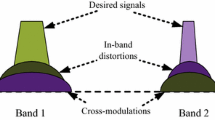Abstract
This paper deals with digital base band signal processing algorithms, which are seen as enabling technologies for software-enabled radios, that are intended for the correction of the analog front end. In particular, this paper focuses on the design, optimization and testability of predistortion functions suitable for the linearization of narrowband and wideband transmitters developed with a hybrid DSP/FPGA platform. To select the best algorithm for the identification of the predistortion function, singular value decomposition, recursive least squares (RLS), and QR-RLS algorithms are implemented on the same digital signal processor; and, the computation complexity, time, accuracy and the required resources are studied. The hardware implementation of the predistortion function is then carefully performed, in order to meet the real time execution requirements.














Similar content being viewed by others
References
Mitola, J. (1995). The software radio architecture. IEEE Communications Magazine, 33(5), 26–38 May.
Eyre, J., & Bier, J. (2000). The evolution of DSP processors. IEEE Signal Processing Magazine, 17(2), 43–51 March.
Paterson, K. G., & Tarokh, V. (2000). On the existence and construction of good codes with low peak-to-average power ratios. IEEE Transactions on Information Theory, 46(6), 1974–1987 Sep.
Cavers, J. (1990). Amplifier linearization using a digital predistorter with fast adaptation and low memory requirements. IEEE Transactions on Vehicular Technology, 39(4), 374–382 Nov.
Boumaiza, S., Helaoui, M., Hammi, O., Liu, T., & Ghannouchi, F. M. (2007). Systematic and adaptive characterization approach for behavior modeling of dynamic nonlinear transmitters. IEEE Transactions on Instrumentation and Measurement, 56, 2203–2211.
Boumaiza, S., & Ghannouchi, F. M. (2002). Realistic power amplifiers characterization with application to base band digital predistortion for 3G base stations. IEEE Transactions on Microvave Theory and Techniques, 50(12), 3016–3021 December.
Cripps, S. C. (2003). RF power amplifiers for wireless communications (2nd ed.). Norwood, MA: Artech House.
Kim, J., & Konstantinou, K. (2001). Digital predistortion of wide-band signals based on power amplifier model with memory. Electronics Letters, 37(23), 1417–1418 Nov.
Wood, J., LeFevre, M., Runton, D., Nanan, J. C., Noori, B. H., & Aaen, P. H. (2006). Envelope-domain time series (ET) behavioral model of a Doherty RF power amplifier for system design. IEEE Transactions on Microvave Theory and Techniques, 54(8), 3163–3172 August.
Zhu, A., Pedro, J. C., & Brazil, T. J. (2006). Dynamic deviation reduction-based volterra behavioral modeling of RF power amplifiers. IEEE Transactions on Microvave Theory and Techniques, 54(12), 4323–4332 December.
Liu, T., Boumaiza, S., & Ghannouchi, F. M. (2006). Augmented Hammerstein predistorter for linearization of broadband wireless transmitters. IEEE Transactions on Microvave Theory and Techniques, 54(4), 1340–1349 April.
Helaoui, M., Boumaiza, S., Ghazel, A., & Ghannouchi, F. M. (2006). Power and efficiency enhancement of 3G multi-carrier amplifiers using digital signal processing with experimental validation. IEEE Transactions on Microvave Theory and Techniques, 54(4), 1396–1404 April.
Haykin, S. (2002). Adaptive filter theory (4th ed.). Upper Saddle River, NJ: Prentice-Hall.
Kwan, A., Boumaiza, S., Smith, M., & Ghannouchi, F. (2006). Automating the verification of SDR base band signal processing algorithms developed on DSP/FPGA platform. In IEEE Workshop on Signal Processing Systems Design and Implementation (pp. 5–9), Oct.
Acknowledgement
The authors would like to thank Christopher Simon of the Department of Electrical and Computer Engineering in the Schulich School of Engineering at the University of Calgary, Calgary, AB, Canada, for providing technical support during the measurements.
Author information
Authors and Affiliations
Corresponding author
Additional information
This work was supported by the Informatics Circle of Research Excellence (iCORE), the Natural Sciences and Engineering Research Council of Canada (NSERC), Analog Devices Inc. and Canada Research Chairs (CRC).
Rights and permissions
About this article
Cite this article
Kwan, A.K.C., Helaoui, M., Boumaiza, S. et al. Wireless Communications Transmitter Performance Enhancement Using Advanced Signal Processing Algorithms Running in a Hybrid DSP/FPGA Platform. J Sign Process Syst Sign Image Video Technol 56, 187–198 (2009). https://doi.org/10.1007/s11265-008-0225-3
Received:
Accepted:
Published:
Issue Date:
DOI: https://doi.org/10.1007/s11265-008-0225-3




